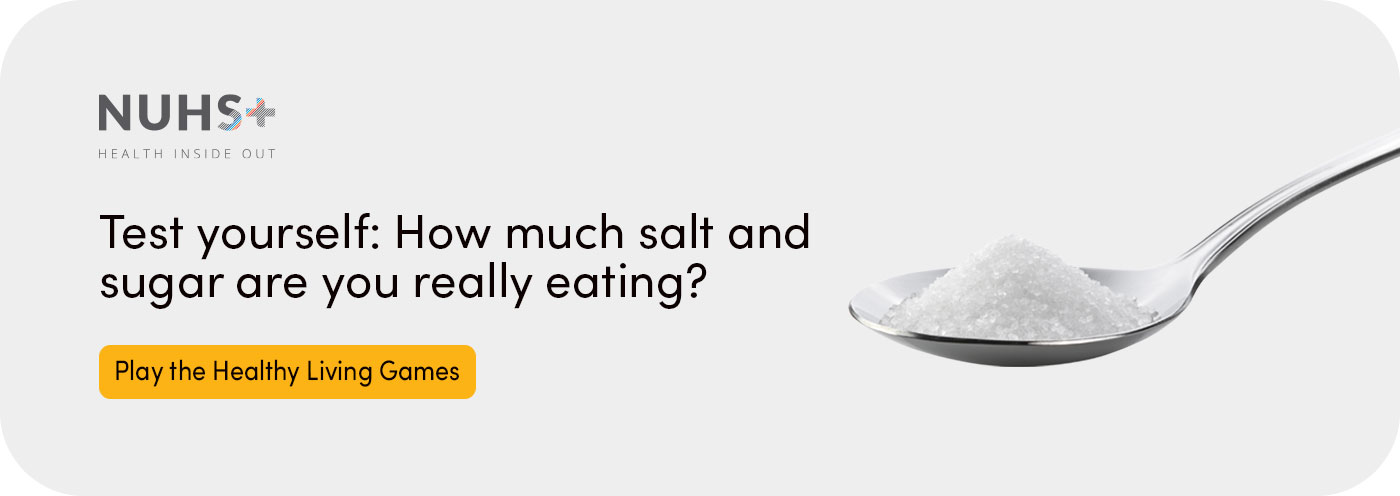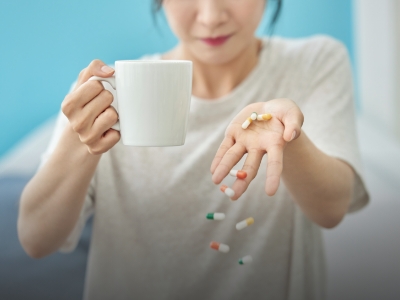Published on 24 November 2025
Ordering kopi siew dai or clear soups may feel like the healthier option, but many common hawker dishes hide far more sugar and salt than expected.
Despite growing awareness of healthier eating, many Singaporeans are still unknowingly taking in excessive sugar and salt from common hawker choices.
A bowl of fishball noodles or a seemingly less-sweet kopi can contain more sodium or sugar than expected, said dietitians from the National University Hospital (NUH) and the NUHS Regional Health System Office (RHSO).
“Many of our everyday favourites come with hidden amounts of salt and sugar,” said Ms Tan Kim Fong, Principal Dietitian at NUH and Community Dietetics Lead at the RHSO. “It’s not always the dishes that taste salty or sweet. Clear soups and even less-sweet drinks can contain more salt or sugar than you’d expect.”
Your sweet slip-ups
Sweet treats are obvious culprits, but savoury comfort dishes and drinks can be just as sneaky. That less sweet kopi or freshly squeezed juice? Not as innocent as it looks.
A milk tea with pearls at a 100 per cent sugar level contains eight teaspoons of sugar, while a kopi siew dai still hides about three-and-a-half teaspoons.
“Siew dai doesn’t mean no sugar. It just means less than the regular version,” said Ms Tan. “Because kopi and teh are made with condensed milk, even a siew dai drink can raise blood sugar quickly.”
“Excess sugar that isn’t used for energy gets stored as fat,” she added. “Over time, that leads to weight gain and raises the risk of Type 2 diabetes and heart disease. Cutting back gradually helps retrain your taste buds and soon you’ll prefer less-sweet flavours.”
Swap the sweet
|
Why your noodles aren’t as ‘light’ as you think
If your drink was not the real villain, your noodles might be. Soups and sauces are sodium traps, with much of the salt coming from soya sauce, seasoning powders, gravies and processed side dishes such as fishcakes.
“Even clear-looking soups can be very high in salt,” said Ms Low Choon Hui, Senior Dietitian at NUH and Dietitian with RHSO. “Many hawkers rely on stock cubes, sauces and pre-mixes for consistency and flavour. Over time, our taste preferences have shifted to stronger, saltier food, so what’s ‘normal’ to us may already be too salty.”
On average, Singaporeans consume about 9g of salt a day – nearly double the World Health Organization’s limit of 5g.
“High salt intake causes the body to retain fluid, putting pressure on blood vessels. This increases the risk of hypertension, heart disease and kidney problems,” said Ms Low.
Her advice: “Ask for less gravy, skip extra sauces or request for the sauce on the side. If you’re having soup noodles, enjoy the ingredients but try not to finish the broth – that’s where most of the salt is.”
How much salt is in your meal
We should consume less than 5g of salt per day.
| Dish | Salt (g) | % of daily limit (5g) | Key sodium sources |
|---|---|---|---|
| Fishball noodles soup | 9.5 | 190% | Soup base, fishballs |
| Mee soto | 6.7 | 134% | Broth, chicken seasoning |
| Lor mee | 6.3 | 126% | Thick gravy, braised toppings |
| Chicken macaroni soup | 4.3 | 86% | Soup stock, minced meat seasoning |
| Chicken briyani | 3.6 | 72% | Curry gravy, marinated meat |
| Nasi lemak (with chicken wing) | 3.0 | 60% | Sambal, fried chicken, ikan bilis |
| Mac & cheese | 3.2 | 64% | Cheese sauce, processed ingredients |
| French fries | 0.7 | 14% | Added salt, seasoning |
The numbers do not mean one dish is healthier than another. Fishball noodles may have more salt than nasi lemak because of the soup, while nasi lemak can be higher in fat and calories. French fries, for instance, are usually eaten as a side dish, and the total salt intake can climb quickly when paired with a main meal. The table above shows how sodium hides in soups, sauces and sides. The key is to be aware and make small tweaks when you order.
Small changes, big pay-off
When it comes to enjoying hawker favourites, balance is key.
“If you’ve had a heavier meal for lunch, go for something lighter at dinner,” said Ms Tan. “The idea is to make mindful adjustments rather than follow strict restrictions. Small, consistent changes really add up.”
Listen to your body’s cues. Feeling unusually thirsty after a meal often means it was high in salt. Craving sweets soon after eating may signal a sugar spike and crash.
A digital helping hand
In consultation with Ms Tan Kim Fong, Principal Dietitian, NUH, and Community Dietetics Lead, NUHS Regional Health System Office (RHSO); and Ms Low Choon Hui, Senior Dietitian & NU-LITE Programme Lead, NUH.
Infographics by RHSO, partnering the community to bring health closer to home.





